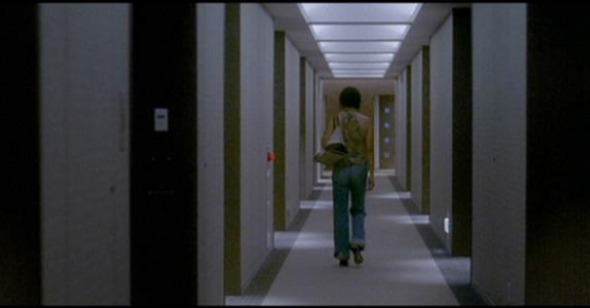Touching the Void
Michael Joshua Rowin on demonlover
“The only thing not prerecorded in a prerecorded universe is the prerecordings themselves: the master film. The unforgivable sin is to tamper with the prerecordings . . . We might say that the next radically new concept biologically speaking will be the transition from Time to Space. This transition consigns the entire Time film, a whole prerecorded and prefilmed universe, to the scrap heap.”
—William S. Burroughs, The Place of Dead Roads
If demonlover was one of the most scrutinized films of 2003, it was because director Olivier Assayas boldly chose to so directly enter, as well as represent, the new technology at the center of image circulation and the multibillion dollar entertainment industry. His camera captures manga, anime porn, 3-D graphics, and video games, all readily consumed but rarely acknowledged, especially in contemporary cinema. Its title is apt—the word “demon” originates from the Greek daïmon, meaning “divine power,” a term fitting for the status images wield in the 21st century. Connecting image culture with sex and violence within the struggle for global influence via new media, demonlover’s complex plot—concerning Diane de Monx’s entrance into a world of double and triple crosses in her company’s takeover of cartoon porn manufacturer TokyoAnimé—transcends metaphor and enacts a deconstruction of our spectacle-obsessed society.
Simultaneously ghostly and tangible—or “there and not there,” as coworker Hervé says of Diane—the hi-tech in demonlover comes directly into conflict with the “ancient” medium of film. The appearance of violent, spastic animated pornography explodes the screen, rupturing linear progression by making time stand still for desire while also initiating a move into transgressive spatial dimensions. Desire becomes control, control becomes power: while the perpetual present of these images loosens time’s stranglehold on life, Assayas doesn’t envision immortality but instead the individual’s endless journey through demon-infested nightmares. Simply put, demonlover is about control.
Unlike The Matrix’s video game omnipotence, demonlover remains critical, cautious. Manga and anime porn function within cinematic quotation marks, like found footage, and the overall feel of Assayas’s film is one of detachment, not absorption. The eventual leap into a pure spatial sensorium at the expense of narrative cohesion begins only after the viewer receives a thorough tour of capitalism’s staging grounds, the headquarters of the ubiquitous VolfGroup. Like Peter Watkins’s La Commune (Paris 1871), which combined digital video immediacy with old-school agitprop, Assayas’s film studies media’s status as commodity and weapon. Commodification extends to demonlover’s characters: repeatedly framed behind windows reflecting a streamlined external world, visages become disembodied, exchangeable abstractions. These shots rhyme with the swish pans and nighttime photography that create ephemeral light spheres and flickering tears in the image, forming correspondences between the alienating modern landscape and its inhabitants.
When dissolution of the optical field finally bursts into frenzied, hallucinatory disorder (reminiscent of Irma Vep’s self-destructive denouement, in which scratches and markings on the emulsion signal, as well as resolve, artistic frustration), demonlover appropriates the structural characteristics of current media like music videos that dispense with narrative causality in favor of plastic free association. Is this a pertinent tactic in foregrounding the workings of new entertainment, or is it a mere aesthetic indulgence? I believe it’s the former: Assayas not only subverts film’s temporal dimension by constructing scenes which exist outside of time and within a sort of mental space, he also rescues entertainment’s nihilistic paroxysm of repressed violence and carnality by concentrating on the solitude of the dislocated subject. After being dragged through a disorienting labyrinth of betrayal both human and technological, Diane wears an expression of numb resignation as the flames of a crashed, burning car snap around her in the middle of a desert wasteland. Rarely has a film gathered such visual poetry from the literal and figurative ashes of the dead forms it has left behind.
On my initial viewing of demonlover I took issue with its epilogue, in which Diane appears on a teenager’s computer screen as a Hellfire Club victim awaiting interactive torture. I thought the intended message was didactically stated. But watching the film again, I couldn’t help but think of the capture of Saddam Hussein and its subsequent verification via images of the former dictator, the camera dissecting his ravaged face. The image’s power lies here, in its ability to serve several masters without faithfulness to any of them. Hussein, ruler of the state apparatus at one moment, becomes everyone’s very own insect under glass at another. In the next presidential election, candidates will be vying for political control through mastery of the image, and despite Americans’ self-satisfaction in being “media-savvy,” appearances, rather than ideas, will most likely inform decisions. "As Diane worries out loud, 'Nobody sees anything. They look but don't understand.'" During this period, Assayas’s film will be on my mind—as one of the few examples of a film confronting contemporary media, its portrayal of a world inundated by visual demons is frightening, confusing, and very, very real.
